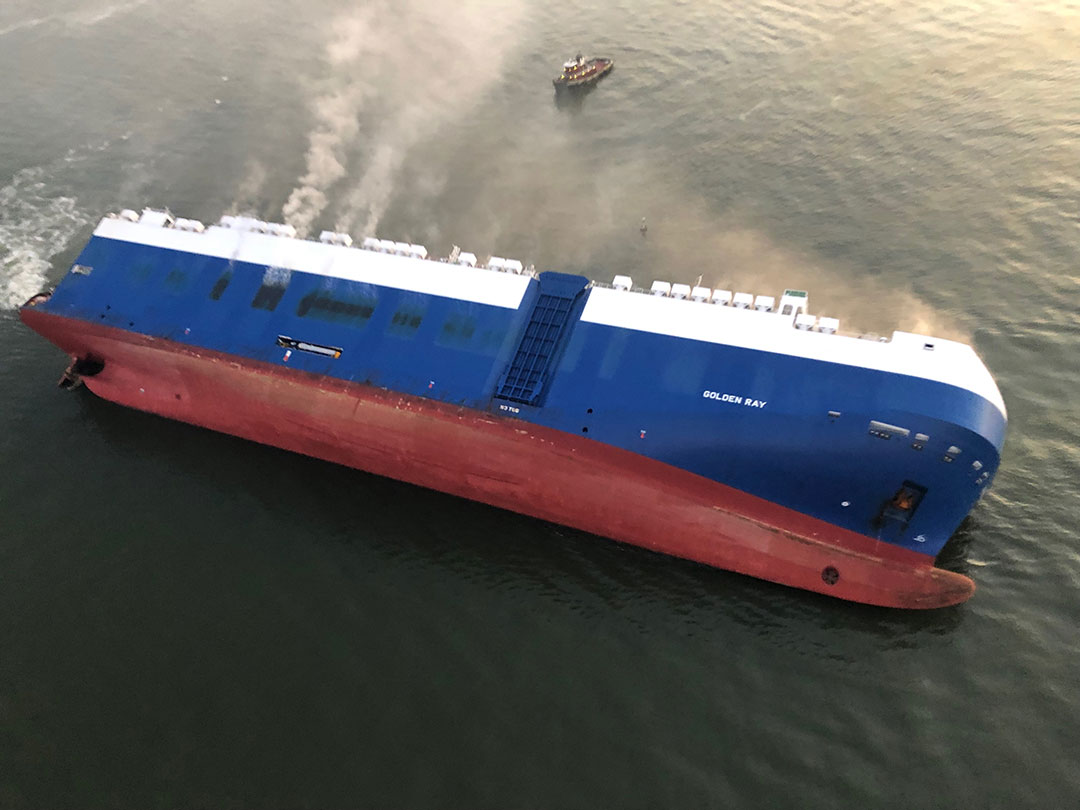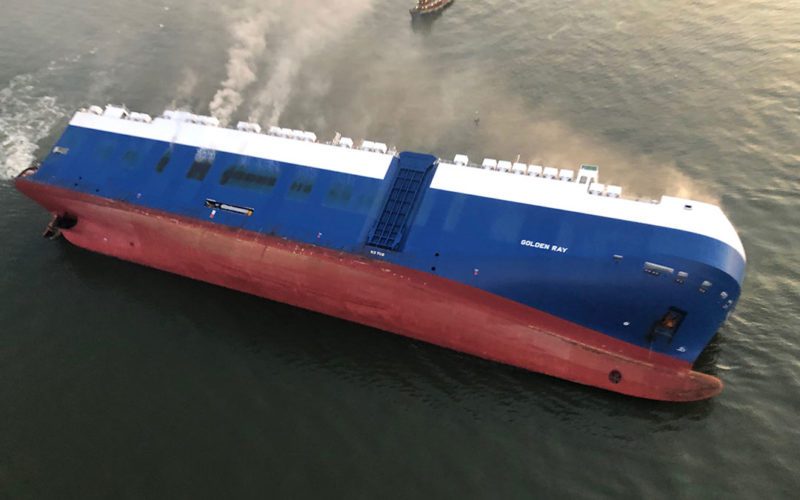
The vehicle carrier Golden Ray capsized in St. Simons Sound due to a crucial vessel stability miscalculation and inadequate training and safety procedures, the National Transportation Safety Board (NTSB) concluded.
Investigators said the chief officer entered incorrect ballast levels into a shipboard computer, indicating the vessel had more water than it actually did. As a result, Golden Ray’s center of gravity was “significantly higher” than calculated.
“Golden Ray capsized because it did not possess enough righting energy to counter the port heeling moment created during the attempted execution of the 68-degree starboard turn,” the NTSB said in its accident report.
The 656-foot ship capsized Sept. 8, 2019, at 0140 while outbound from the Port of Brunswick. It had 23 crewmembers and a pilot on board, along with 4,067 vehicles. Two crewmembers suffered serious injuries, and four engineering personnel were trapped inside the ship for 40 hours.
Damage from the incident was substantial. The loss of the vessel was estimated at $62.5 million, while the vehicle cargo below deck was worth $142 million. The salvage effort to remove the ship is nearly complete at a cost approaching $850 million.
The Marshall Islands-flagged ship left the Port of Brunswick dock at about 0030 under the control of a pilot. The voyage proceeded normally as the ship approached the 68-degree turn around the northern point of Jekyll Island at about 13 knots.
The pilot issued starboard rudder commands followed by a return to midships. That’s when the trouble started.
“The helmsman complied with the pilot’s order, and, according to the pilot, the ‘ship just took off,’” the report said. “At 0136:58, the vessel started to heel to port. The pilot stated that as the vessel began to turn, it ‘felt directionally unstable … meaning when I started the turn, she wanted to keep turning.’”
Attempts to counter the heeling motion weren’t successful. The pilot radioed for help, spurring a massive rescue effort involving federal, state and local resources. Eleven crewmembers were lowered from the bridge to a Coast Guard vessel via fire hose, including the pilot and master. Responders rescued five more crew, and two others were hoisted off the starboard side by a Coast Guard helicopter.
Two other crewmembers were rescued by 0645, including the chief engineer, who escaped by breaking his cabin window. Three engineering crewmembers and an engineering cadet were trapped in the engine room and engine control room by water that flooded the ship when it rolled over. Those spaces were completely dark, and the men had only a single flashlight.
“As time went by, the air temperature within the engine room rose,” the report said. “According to the engineers, the excessive heat made it very uncomfortable and hard for them to breathe, and they eventually entered the flood water to stay cool.”
Rescue personnel located the missing crew after hearing tapping on the hull. They drilled large holes into the ship to rescue the men. Two engineers and the cadet escaped the vessel at about 1500 on Sept. 9, and the final crewmember left the ship about 2.5 hours later.
Two fires started in the ship in the days following the capsizing. One started at about 0430 on Sept. 8 in the vehicle decks that burned itself out within 24 hours. The second started on Sept. 9, minutes after the last crewmember was rescued. It burned only a few hours.
Prior to getting underway, Golden Ray’s chief officer manually entered ballast data into the ship’s LoadCom computer. He did this even though the system can automatically retrieve ballast data from the ship’s monitoring and control system.
The chief officer did not use a software feature to measure the vessel’s metacentric height, known as GM. That is the distance from the ship’s center of gravity to its metacenter, and it measures the vessel’s ability to right itself.
Investigators also learned ship operator G-Marine Service Co. lacked procedures that might have caught the error. The chief officer was solely responsible for calculating stability, and there were no checks in place for another officer to verify his work.
“This practice — when only the chief officer was responsible for a safety-critical task without a backup to help identify possible errors — allowed a single point of failure to occur,” investigators said.
The chief officer joined Golden Ray about six months earlier, and he had 10 years of experience as a chief officer. He did not receive formal training on the stability computer, and G-Marine Service Co. had no means to confirm he knew how to use it.
“The operator did not provide official training on crew positions and responsibilities to new crewmembers but instead relied on a combination of newly hired crewmembers’ experience and knowledge as well as on-the-job training,’’ the report said.
Since the accident, G-Marine Service has adopted policies to increase training for chief officers on stability, cargo management and the LoadCom computer. The company also requires that chief officers compare their computer calculations to an onboard booklet of tables of similar loading conditions to ensure adequate stability.
The company now requires a final load plan and stability verification before vessels leave port. It has also begun to replace LoadCom computers with a new system that will be standardized across its fleet.
Additionally, a January 2020 amendment to the International Marine Organization International Convention for Safety and Life at Sea requires the master on cargo vessels to determine the ship’s trim and stability, according to the NTSB report.
Attempts to reach G-Marine Service, a subsidiary of logistics company Hyundai Glovis Co. Ltd., were not successful. Hyundai Glovis, part of the Hyundai Kia Automotive Group, did not respond to an inquiry about the NTSB findings.

